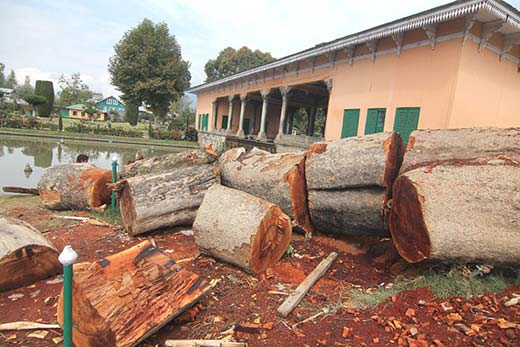By: Mir Liyakat Nazir
Jis khak ke zamir main ho aatishe Chinar
Mumkin nahin ki sard ho wo khaakee arjumand…
(The dust that has in its conscience the fire of Chinar trees/ that dust, celestial dust, will never become old)
 This couplet of Allama Iqbal is not only a poetic tribute to the resilient nature of the people of valley who for generations had to endure the unremitting sufferings but unveils the importance of this tree in the cultural and political identity of Kashmir.
This couplet of Allama Iqbal is not only a poetic tribute to the resilient nature of the people of valley who for generations had to endure the unremitting sufferings but unveils the importance of this tree in the cultural and political identity of Kashmir.
History and poetic gospels say that the people of the state can be easily hoodwinked and exploited by the political gimmicks and rhetoric’s but their innate sentiment cannot be quelled no matter how brute force you unleash on them.
The Chinar tree symbolizes all that Kashmiris are known for, but unfortunately both resilience and the gigantic Chinar trees are dwindling and disappearing. As we know that materialism and crime have waved such a strong web around our society that we can just watch like a mute spectator because as a nation we fail to navigate as well as anticipate the moral, social and cultural responsibilities since the armed conflict begin in the Kashmir.
In a conflict zone, the physical loss as well as the economical loss is inevitable, but least we can do is to protect our cultural heritage and protect and preserve them from the cruel spats of time.
The forests are disappearing, the rivulets and streams are shrinking and the trees are cut at its will because there is nobody in the state to check and stop this alarming trend. The most shocking and worrying trend in the valley is that the majestic Chinar tree is on the verge of extinction and experts say that these riches of heritage and environment-friendly trees may face complete extinction in the next few years if immediate measures are not taken for their maintenance and survival.
It would be detrimental of staining our faces by cutting Chinar trees knowing fully that how it stood tall in all odds and ages, served as a muse to our great poets and artists because of its all season beauty.
It is said that during Emperor Aurangzeb’s reign, an inferno engulfed the grand mosque of Srinagar and razed it to cinders. Aurangzeb wrote to his appointed governor on the tragedy and enquired about the fate of Chinar trees grown in the lawns of the mosque.
On knowing that the Chinars were safe, he remarked, “the mosque can be rebuilt in a year or two, but it would have taken a long time to beautify it with Chinars.”
But the current successive regimes and the representatives of the people across all ideologies have not only turned a blind eye on the apathy of Chinar trees but limited their ‘campaign to restore their glory’ just to the golden laying eggs projects and nothing else.
Today this majestic tree is facing an onslaught both from the people and administration in the name of construction, road widening and felling. Due to that we hardly find Chinar trees in urban as well as in rural areas of the valley.
We as a nation have a bizarre tendency to ignore and forget our rich cultural heritage and the Chinar facing the axe and wrath by the people is yet another gory example of conscious less society. We forget in a swing of time that how in the social and cultural milieu’s this tree played its multiple roles by serving the land marks, place of rest for tired travellers, farmers, a venue for festivals and a hot spot for children to play hide and seek in its huge shadow.
It never became threat to our environment like the other trees posed which were exported from other parts of the world for their commercial utility turning Kashmir into an allergic and polluted with pollens.
Historically the Chinar tree in Kashmir is not only a tree but a silent chronicler as well as witness to all ages and periods in which the people of valley lived and suffered under different occupying regimes. Its crimson leaves define the very character of people who neither bow down to the might of power nor their hearts and minds can be won by unleashing hell upon them.
In the literary discourse of Kashmir, Chinar tree has not only enriched its content and themes but acted as a creative inspiration to the different local and non-local poets.
If the ruthless cutting of Chinar trees continues in the name of urbanization and development across the valley then the day is not far away when we find them only in the fiction books.
We need to pull up our socks and do something as soon as possible to save our riches of heritage; time to wake from the deep slumber before it gets too late.














